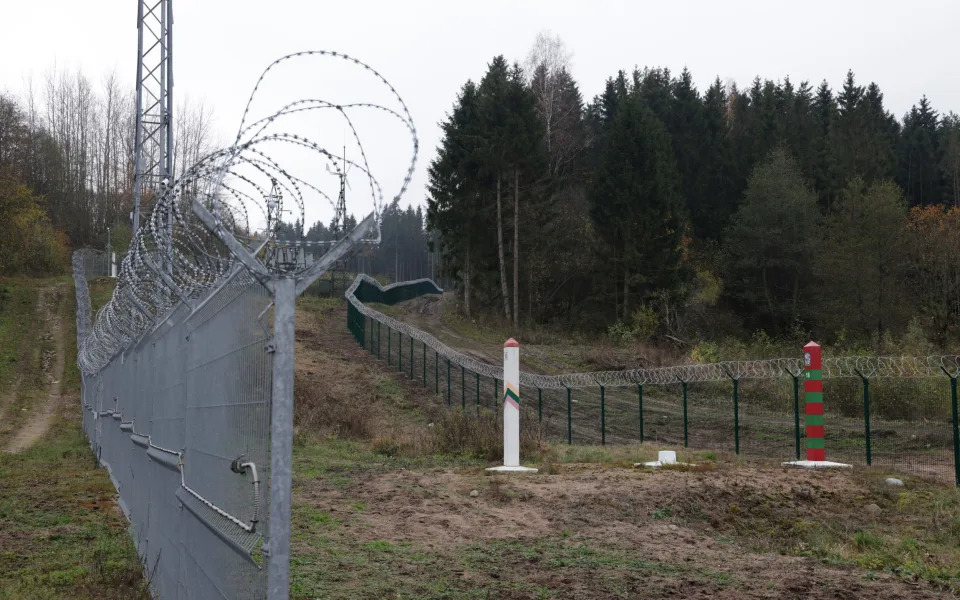The Telegraph
The Latvian sandwich makers training to push Putin’s army into ‘kill zones’
Sophia Yan – March 21, 2024

For most of the year, Matiss Lopsa makes sandwiches in a fashionable cafe in eastern Latvia, but for a few weeks the 21-year-old puts his apron aside and picks up a rifle to train with the national guard.
His home town, Rezekne, lies 35 miles from the border with Russia and is on a direct road to Moscow.
The proximity to danger is not lost on Mr Lopsa.
In January, Latvia reintroduced conscription for men aged 18 to 27 – even for those living abroad. Two years into Russia’s invasion of Ukraine, there are growing fears that Vladimir Putin could make a strike against Nato.
“I thought the government might bring back the draft,” said Mr Lopsa. “So I decided to volunteer, to choose to do this myself now, rather than be surprised if I was suddenly called up.”
He believes the government was right to begin training men like himself how to fight.
“I’m all for it – I think it’s a very, very good way to discipline young men,” said Mr Lopsa, after a day spent tossing meat and vegetables onto flatbread.
“That way, if you are called into war, you won’t be caught short on the first day not physically knowing how to do anything.”

It is in anticipation of that “first day” that the Latvian government is seeking to expand its armed forces to 61,000, between active and reserve forces.
In 2024, the military will draft a total of 600 soldiers, with the goal of bringing in 4,000 per year by 2028.
There are exceptions, for example men who are the sole guardians of children or elderly parents, or are studying at university.
Draft-dodgers face fines and a prison sentence of up to five years during wartime.
Latvia is also developing the capabilities of its military. The government has procured new weapons systems from the US, including the Himars rocket system – a key part of Ukraine’s defence against Russia.
It has also purchased German Iris-T air defence units and a naval coastal defence system produced by Kongsberg, a Norwegian firm, and US defence contractor Raytheon. The government has agreed to construct a defensive line with neighbouring Estonia and Lithuania.
Together, the three Baltic nations share the longest Nato border with Russia and Belarus, running about 1,000 miles.

One concern along that stretch of land is the lack of geographical obstacles to any invading force.
Tomas Jermalavicius, the head of studies at the International Centre for Defence and Security in Estonia, said: “There are places where there are thick woods and rivers. But there are also places where it’s really wide open, and where it’s really close to critical points.
“If there are no obstacles … the enemy could be standing at the capital doors in no time.”
Targets that could be vulnerable include Lithuania’s capital, Vilinius, and Latvia’s second-largest city, Daugavpils – both less than 20 miles from the border to Belarus.
There’s also the Suwalki Gap, a roughly 60-mile land strip on the border between Poland and Lithuania. It’s a choke point, flanked to the West by the Russian enclave of Kaliningrad and to the east by Belarus, an ally of Moscow.
Were Moscow to seize this strip – known as Nato’s Achilles’ Heel – Estonia, Latvia and Lithuania would be severed from their Nato allies.

Estonia’s new border defence plan aims to address these concerns by working to “channel advancing forces into ‘kill zones’ identified by the defenders for drone fire, for artillery – to turn those channels into a meat grinder”, said Mr Jermalavicius.
While details are still being worked out, Estonia has already said it will build hundreds of bunkers that can withstand direct artillery fire.
Working together is crucial.
“If Estonia does something Latvia does not do, and it becomes possible to launch an attack on Estonia through Latvian territory – this kind of stuff needs to be co-ordinated,” Mr Jermalavicius said.
Already, Latvia is incorporating lessons from the battlefield in Ukraine, where the country’s military instructors have helped to train local soldiers – an exchange that has boosted understanding both ways.
Troops are no longer only drilling in open fields but learning how to engage enemy combatants in urban settings.
But not everyone is as positive about the draft as Mr Lopsa.
Two teenage boys, 16 and 17, in Zilupe, a tiny Latvian town about four miles from Russia, simply laughed off the prospect.
Another boy, 17, told The Telegraph that he’d simply leave the country to evade service.
Konstantin Tupikins, 28, who has just aged out of the military requirement, thinks his younger brother, 15, would not make it as a soldier.
“He’s not really someone with this kind of bravery and courage,” said Mr Tupikins, who now works in the UK, and was home to visit his mother in Zilupe.

On a wintry walk with her daughter in a pram, 28-year-old Ekaterina is “quite against” the idea.
“The government hasn’t done enough for us; for people with disabilities or parents with prams, these winter sidewalks aren’t safe,” she said, gesturing at the icy paths, and declining to give a surname.
“Now they’re asking us to give our children?”
War would especially impact border towns like Zilupe – first, as a potential target given close proximity to Russia; and second, because the majority of its nearly 1,400 residents are Russian.
The primary language here is Russian – not Latvian, nor the local dialect, Latgalian.
Experts worry that these eastern reaches of Latvia – with villages populated by Russians and Belarussians – could give Putin fodder to “justify” an invasion and to establish “people’s republic”, as he did in Ukraine with Donetsk and Luhansk.
Many of Zilupe’s residents settled here before the dissolution of the Soviet Union, retaining family ties in Russia.
Before war broke out in Ukraine, people travelled often between Latvia and Russia.
Trips were so frequent that the train station – the last stop before Russia – is still plastered with signs of what travellers can bring into the EU, including a maximum of 125 grams of caviar.
Some still make the trek, though far fewer do so now, as Latvia has closed many border crossings to Russia and Belarus. Cross-border trains have largely stopped, and untouched snow blankets the tracks running east.
Families on both sides of conflict
The town’s complicated dynamics are perhaps best demonstrated by the fact that residents have sons and nephews enlisted on both sides in the Russian and Ukrainian militaries.
Vladimir, 89, who lives in Zilupe and is from Ukraine, with a son in the military, said: “I regret that innocent young people have to get involved in war. Latvia’s demographics are so old, and now we have to send our youths.”
In Riga, the capital, support for Ukraine remains overwhelming. Government buildings hang Ukraine’s flag and its blue-and-yellow colours can be found on everything from tram doors to trinkets such as coffee cups and candles.
While this reflects widespread unease that Latvia could find itself in Putin’s path, it also reveals a deep-seated resolve to defend the country’s hard-won independence.
The Freedom Monument, a 42-metre sculpture of a copper Liberty erected in 1935, stands testament to that desire.
The statue, which survived decades under Soviet occupation, is guarded today by two soldiers at its stone base; police officers patrol the square.
Krisjanis Karins, Latvia’s foreign minister, said: “We simply have to do things differently than if we weren’t living next to Russia. And, you know, Latvia has always been next to Russia.
“It has never been a democratic country … and this is what’s troubling,” he said. “They won’t stop of their own accord; they can only be stopped.
“They need to run up against the brick wall, and that brick wall needs to be Nato resolve and proven capabilities.”
